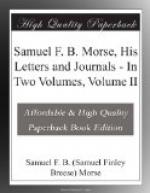“Early in 1836 I procured forty feet of wire, and, putting it in the circuit, I found that my battery of one cup was not sufficient to work my instrument. This result suggested to me the probability that the magnetism to be obtained from the electric current would diminish in proportion as the circuit was lengthened, so as to be insufficient for any practical purposes at great distances; and, to remove that probable obstacle to my success, I conceived the idea of combining two or more circuits together in the manner described in my first patent, each with an independent battery, making use of the magnetism of the current on the first to close and break the second; the second the third; and so on.”
Thus modestly does he refer to what was, in fact, a wonderful discovery, the more wonderful because of its simplicity. Professor Horsford thus comments on it:—
“In 1835 Morse made the discovery of the relay, the most brilliant of all the achievements to which his name must be forever attached. It was a discovery of a means by which the current, which through distance from its source had become feeble, could be reenforced or renewed. This discovery, according to the different objects for which it is employed, is variously known as the registering magnet, the local circuit, the marginal circuit, the repeater, etc.”
Professor Horsford places the date of this discovery in the year 1835, but Morse himself, in the statement quoted above, assigned it to the early part of 1836.
It is only fair to note that the discovery of the principle of the relay was made independently by other scientists, notably by Davy, Wheatstone, and Henry, but Morse apparently antedated them by a year or two, and could not possibly have been indebted to any of them for the idea. This point has given rise to much discussion among scientists which it will not be necessary to enter into here, for all authorities agree in according to Morse independent invention of the relay.
“Up to the autumn of 1837,” again to quote Morse’s own words, “my telegraphic apparatus existed in so rude a form that I felt a reluctance to have it seen. My means were very limited—so limited as to preclude the possibility of constructing an apparatus of such mechanical finish as to warrant my success in venturing upon its public exhibition. I had no wish to expose to ridicule the representative of so many hours of laborious thought.
“Prior to the summer of 1837, at which time Mr. Alfred Vail’s attention became attracted to my telegraph, I depended upon my pencil for subsistence. Indeed, so straitened were my circumstances that, in order to save time to carry out my invention and to economize my scanty means, I had for months lodged and eaten in my studio, procuring my food in small quantities from some grocery, and preparing it myself. To conceal from my friends the stinted manner in which I lived, I was in the habit of bringing my food to my room in the evenings, and this was my mode of life for many years.”




